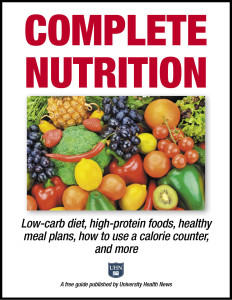Listeria Symptoms: Telltale Signs of a Food-Borne Virus
On Nov. 16, 2017, the food chain Stop & Shop issued a recall of Own Brands Frozen Whole Kernel Sweet Corn due to possible listeria contamination. Listeria is the third-leading cause of death from food poisoning in the United States. Each year, it’s blamed for approximately 1,600 illnesses and around 260 fatalities. So what is listeria, and how can we identify listeria symptoms?
Listeria, or listeriosis, is a food-borne infection caused by the bacteria Listeria monocytogenes, which lives in soil and water. It can be found in many foods and can even survive in cold temperatures. Raw milk and dairy products are most commonly implicated in infection, so pregnant women, the elderly, and people with immune system deficiencies are advised to avoid these items.
Eat Right, Starting Now!
Download this expert FREE guide, Complete Nutrition: Low-carb diet, high-protein foods, healthy meal plans, how to use a calorie counter, and more.
Create healthy meal plans and discover the Superfoods that can transform your plate into a passport to better health.
Listeria Symptoms
According to the Centers for Disease Control and Prevention (CDC), most people exposed to Listeria monocytogenes will experience mild symptoms at worst. Pregnant women, newborn babies, elderly adults, and people with immune system deficiency are more likely to fall ill with Listeria and are at risk of serious illness. Listeria symptoms include:
- Fever, with or without chills.
- Diarrhea, vomiting, and abdominal cramps.
- Fatigue and muscle aches. These are usually seen only in at risk groups.
- Headache, stiff neck, confusion, loss of balance, and convulsions are signs of serious infection: See your doctor if you develop these symptoms along with fever and diarrhea, as they may be a sign of sepsis (spread to bloodstream), meningitis or encephalitis (spread to brain) and other body systems or organs.
In pregnant women, listeria can lead to miscarriage, stillbirth, premature delivery, or life-threatening infection of the newborn.
Symptoms usually take one to four weeks to develop after eating contaminated foods, but incubation periods as long as 70 days have been reported.
SOURCES & RESOURCES
For more information on Listeria, visit:
- Centers for Disease Control and Prevention. Provides general guidance on Listeria.
- U.S. Food and Drug Administration. Provides advice on food preparation and prevention of Listeria in the home and commercial settings.
Prevention of Listeria Infection
Anyone can catch listeria from infected food. To reduce your chances, especially if you’re in an at-risk group, the CDC and U.S. Food and Drug Administration (FDA) advise:
- Use precooked and ready-to-eat foods as soon as you can.
- Avoid raw milk and raw milk products, like soft cheeses, if you’re in an at-risk group.
- Heat ready-to-eat foods and leftovers until they are steaming hot.
- Wash fresh fruits and vegetables, like salads, raw sprouted vegetables, and melons.
- Avoid rare meat and refrigerated smoked seafood, if you’re in an at-risk group.
- Keep refrigerated foods cold and wrap carefully to avoid leakage. Keep leftovers in your refrigerator, for a maximum of three days.
- Clean and sanitize your refrigerator regularly, with warm soapy water and a dash of bleach.
- Clean up spills on your countertops and fridge, from meats, poultry or raw dairy products, immediately sanitize and clean using disposable paper towels.
- Keep food preparation surfaces clean with warm soapy water and bleach.
- Cutting boards should be washed with warm, soapy water after each use.
- Nonporous acrylic, plastic, or glass boards can be washed in a dishwasher, if you have one.
- Wash hands thoroughly, with soap and water, for at least 20 seconds, before and after handling food and in between prepping different raw foods.
- Dishcloths, towels and cloth grocery bags should be washed often in the hot cycle of your washing machine.
Visit the CDC’s Listeria prevention page to learn more.
What to Do If You Believe You’ve Eaten Listeria-Contaminated Food
Worried that you may have eaten contaminated food within the last month or so? See your doctor if you develop the symptoms listed within this post, especially if you are in an at-risk group. If you feel well after eating contaminated food, be vigilant for symptoms and ask your doctor for advice if you are concerned.
Diagnosis and Treatment of Listeria Infection
If you think you may have listeriosis, your doctor may order bacterial culture testing on feces, and if you or your newborn are very sick, he or she may order testing on blood, spinal fluid, or the placenta. Listeriosis is treated with antibiotics.
Recent Outbreaks of Listeria in the U.S.
Food recalls are relatively common, but most do not lead to a listeria outbreak. If you hear of a recall, there is no need to panic; outbreaks are rare.
The CDC lists these major outbreaks and sources in the last six years:
2017: Vulto Creamery Soft Raw Milk Cheese
2016: Frozen vegetables, raw milk, packaged salads
2015: Soft Cheeses, ice cream.
2014: Commercially produced prepackaged caramel apples, bean sprouts, cheese, dairy products.
2013: Cheese.
2012: Ricotta Salata Cheese.
2011: Cantaloupes.
The post Listeria Symptoms: Telltale Signs of a Food-Borne Virus appeared first on University Health News.
Read Original Article: Listeria Symptoms: Telltale Signs of a Food-Borne Virus »
Powered by WPeMatico


